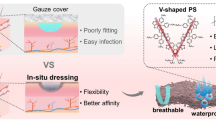Abstract
The antifungal properties and cytotoxicity of alginate fibers were investigated to widen their application in tissue engineering. Calcium, zinc, and copper alginate fibers were separately prepared by replacing Na+ with Ca2+, Zn2+, or Cu2+. The antifungal properties of the three alginate fibers were studied after coming into contact with Candida albicans. Then, the fungal inhibitory rates were measured using the plate-count method following shake-flask test. Moreover, an inhibition-zone test and observation by scanning electron microscopy were carried out. The inhibitory rate of the calcium, copper, and zinc alginate fibers were, respectively, 49.1, 68.6, and 92.2 %. The results from inhibition-zone test and shake-flask test show that zinc alginate fibers have the most significant antifungal action and that copper alginate fibers have obvious inhibitory action, but the calcium alginate fibers have weak inhibitory effects. The scanning electron micrographs similarly illustrate that the fungal surfaces show most scraggly after the interaction between C. albicans and zinc alginate fibers. Moreover, the relative growth rates of zinc or calcium alginate fibers in human embryonic kidney cells and human fibroblast cells were more than 100 %. No significant results were obtained (P > 0.05). The calcium alginate fibers in human fibroblast cells were not much different from the negative control group (P > 0.05). However, zinc alginate fibers had a significant change (P < 0.05). Therefore, the excellent antifungal property of zinc alginate fibers demonstrates potential application in skin tissue engineering comparing with calcium or copper alginate fibers.






Similar content being viewed by others
References
Gristina AG (1987) Biomaterial-centered infection: microbial adhesion versus tissue integration. Science 237(4822):1588–1595
Donlan RM (2001) Biofilms and device-associated infections. Emerg Infect Dis 7(2):277–281
Zdyrko B, Klep V, Li X, Kang Q, Minko S, Wen X, Luzinov I (2009) Polymer brushes as active nanolayers for tunable bacteria adhesion. Mat Sci Eng C–Bio s 29(3):680–684
Speakman JB, Chamberlain NH (1944) The production of rayon from alginic acid. J Soc Dyers Colour 60(10):264–272
Straatmann A, Borchard W (2003) Phase separation in calcium alginate gels. Eur Biophys J 32(5):412–417
Van Biervliet S, Van Biervliet J, Vande Velde S, Robberecht E (2007) Serum zinc concentrations in cystic fibrosis patients aged above 4 years: a cross-sectional evaluation. Biol Trace Elem Res 119(1):19–26
Yang CY, Liu Y, Zhu JC, Dan Z (2008) Inhibitory effect of copper complex of indomethacin on bacteria studied by microcalorimetry. Biol Trace Elem Res 122(1):82–88
Zhang H, Feng J, Zhu W, Liu C, Gu J (2000) Bacteriostatic effects of cerium-humic acid complex. Biol Trace Elem Res 73(1):29–36
Burkatovskaya M, Tegos GP, Swietlik E, Demidova TN, Castano AP, Hamblin MR (2006) Use of chitosan bandage to prevent fatal infections developing from highly contaminated wounds in mice. Biomaterials 27(22):4157–4164
Wu Y, Han GT, Gong Y, Zhang YM, Xia YZ, Yue CQ, Wu DW (2011) Antibacterial property and mechanism of copper alginate fiber. Adv Mater Res 152–153:1351–1355
Miko ajczyk T, Wo owska-Czapnik D (2005) Multifunctional alginate fibres with anti-bacterial properties. Fibres Text East Eur 13(3):35–40
Knill C, Kennedy J, Mistry J et al (2004) Alginate fibres modified with unhydrolysed and hydrolysed chitosans for wound dressings. Carbohyd Polym 55(1):65–76
Lansdown ABG, Mirastschijski U, Stubbs N, Scanlon E, Agren MS (2007) Zinc in wound healing:theoretical, experimental, and clinical aspects. Wound Repair Regen 15(1):2–16
Annabi N, Mithieux SM, Boughton EA, Ruys AJ, Weiss AS, Dehghani F (2009) Synthesis of highly porous crosslinked elastin hydrogels and their interaction with fibroblasts in vitro. Biomaterials 30:4550–4557
Partap S, Muthutantri A, Rehman I, Davis G, Darr J (2007) Preparation and characterisation of controlled porosity alginate hydrogels made via a simultaneous micelle templating and internal gelation process. J Mater Sci 42(10):3502–3507
Zohuriaan-Mehr M, Omidian H, Doroudiani S, Kabiri K (2010) Advances in non-hygienic applications of superabsorbent hydrogel materials. J Mater Sci 45:5711–5735
Thomas S (2000) Alginate dressings in surgery and wound management: part 2. J Wound Care 9(3):115–119
Gong Y, Han G, Li X et al (2011) Cytotoxicity and antiviral activity of calcium alginate fibers and zinc alginate fibers. Adv Mater Res 152–153:1475–1478
Doyle JW, Roth TP, Smith RM, Li YQ, Dunn RM (1996) Effects of calcium alginate on cellular wound healing processes modeled in vitro. J Biomed Mater Res 32:561–568
Lansdown ABG, Mirastschijski U, Stubbs N, Scanlon E, Ågren MS (2007) Zinc in wound healing: theoretical, experimental, and clinical aspects. Wound Repair Regen 15:2–16
Acknowledgments
This study was funded by a grant from the National High Technology Research and Development Program of China (2008AA03Z509), the National Basic Research Program of China (2011CB612308), and Sci-Tech Plan Project of Qingdao (10-3-4-3-6-jch).
Author information
Authors and Affiliations
Corresponding author
Rights and permissions
About this article
Cite this article
Gong, Y., Han, G., Zhang, Y. et al. Antifungal Activity and Cytotoxicity of Zinc, Calcium, or Copper Alginate Fibers. Biol Trace Elem Res 148, 415–419 (2012). https://doi.org/10.1007/s12011-012-9388-7
Received:
Accepted:
Published:
Issue Date:
DOI: https://doi.org/10.1007/s12011-012-9388-7




